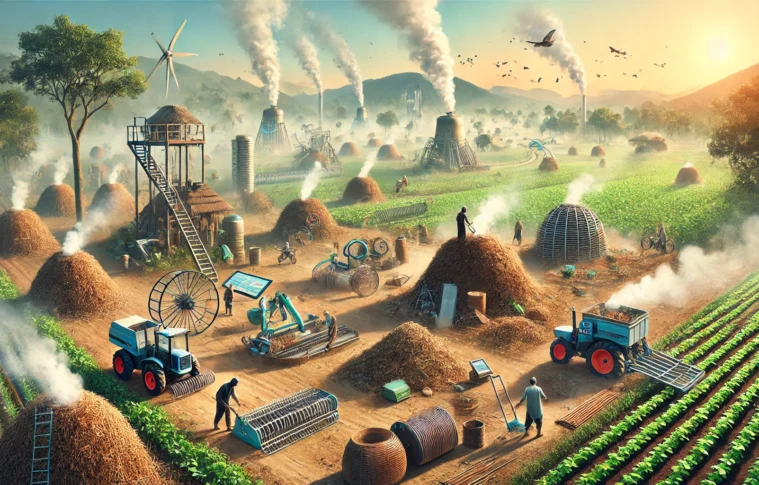Introduction: The Environmental Challenge of Crop Residue Burning
Crop residue burning, a common practice among farmers in India, has become a major environmental concern. Each year, millions of tons of crop residues, such as stubble from rice, wheat, and other crops, are set on fire in the fields after harvest. This practice contributes to air pollution, smog, and the release of harmful greenhouse gases, impacting both human health and the environment. The Indian government has introduced various regulations to curb this practice, but the challenge remains largely unsolved due to a lack of viable alternatives for farmers.
In this context, product management plays a crucial role in identifying sustainable and economically viable solutions to tackle this issue. This case study explores the innovative approaches and product solutions that can address the problem of crop residue burning while considering the needs of farmers, the environment, and local communities.
Understanding the Problem: A Complex Web of Challenges
Crop residue burning is driven by several factors, including the high costs associated with alternative disposal methods, a lack of awareness, and a shortage of efficient technology to manage agricultural waste. For farmers, especially in the northern states of India, where rice and wheat are grown in abundance, burning crop residue has been a time-efficient way to clear the fields for the next planting season.
However, this method is increasingly seen as environmentally damaging and harmful to public health. The smoke from burning residues leads to poor air quality, which exacerbates respiratory diseases and contributes to the seasonal smog that envelops major cities like Delhi. Additionally, the practice leads to the loss of valuable organic matter that could enrich the soil if managed properly.
Key Product Management Takeaway: Understanding the root causes of a problem is crucial in developing solutions that are both effective and feasible for the target market.
Identifying Stakeholder Needs: Farmers, Government, and Communities
To design a successful solution to crop residue burning, it is vital to understand the needs of all stakeholders involved:
- Farmers: Farmers need an affordable, efficient, and accessible alternative to burning crop residue. They also need a solution that fits within their seasonal schedules and aligns with their current farming practices.
- Government: The government’s role is to regulate crop residue burning and provide incentives for sustainable practices. Policies, subsidies, and financial support are critical to motivating farmers to adopt alternative methods.
- Communities and Environmentalists: Local communities and environmental advocates are seeking long-term solutions that reduce air pollution, promote soil health, and contribute to sustainability.
Key Product Management Takeaway: Engaging stakeholders early in the product development process helps identify pain points and opportunities for product-market fit.
Solution 1: Crop Residue Management Machinery
One of the most promising solutions to crop residue burning is the development and deployment of specialized machinery that can help farmers manage crop residues effectively. This includes:
- Tractors and Combine Harvesters with Attachments: These machines are designed to chop, shred, or spread crop residues back into the soil, providing a sustainable way to recycle the organic material. This method enhances soil health by returning nutrients to the land.
- In-situ Biomass Management Equipment: Such equipment, like the Super Straw Management System (SMS) developed by various agricultural machinery companies, is designed to cut and spread the straw evenly across the field, preventing the need for burning.
However, the adoption of such machinery faces challenges in terms of cost, accessibility, and familiarity. For farmers, especially those with smaller landholdings, the high upfront cost of these machines can be prohibitive.
Key Product Management Takeaway: Pricing and accessibility are critical factors in product adoption. Developing cost-effective and scalable solutions for farmers will be key to overcoming barriers to adoption.
Solution 2: Biofuels and Biomass Conversion
Another promising solution is the conversion of crop residue into biofuels or biomass products, such as briquettes, pellets, and biogas. These products can serve as an alternative energy source for rural areas, reducing dependence on traditional fuels like firewood and coal.
- Biofuel Production: The residue can be converted into bioethanol or biodiesel, which can be used as an alternative to fossil fuels in transportation and energy generation.
- Biomass Briquettes and Pellets: These compressed products can be used for cooking, heating, or power generation. By turning crop residue into a valuable product, farmers can generate additional income while reducing waste.
The challenge here lies in the initial investment required to set up biofuel production plants or biomass processing units. However, with the right financial incentives, subsidies, and support from the government, this solution can become a viable option.
Key Product Management Takeaway: Transitioning from an agricultural waste product to a valuable resource requires innovation in both product design and the creation of business models that are financially attractive to farmers and communities.
Solution 3: Crop Residue as Animal Feed and Compost
Another approach to managing crop residue is through its conversion into animal feed or compost. Certain types of crop residue, like wheat and rice straw, can be processed into feed for livestock, providing a valuable resource for rural farmers who also have animals. Additionally, crop residue can be used as a key ingredient in composting, improving soil health and reducing the need for chemical fertilizers.
- Animal Feed Production: With proper processing, crop residues can be turned into nutritious feed for cattle, poultry, and other animals, thus solving two problems: waste disposal and livestock feeding.
- Composting: Crop residue can be processed into compost, enriching the soil and reducing the need for synthetic fertilizers. This method also benefits the environment by creating a natural fertilizer that reduces pollution from chemical runoff.
Key Product Management Takeaway: Creating value-added products from agricultural waste can simultaneously solve waste management and provide additional income opportunities, aligning environmental sustainability with economic incentives.
Government Policy and Financial Support: Enabling Adoption
To ensure the success of these eco-friendly solutions, government policies and financial support are essential. This includes:
- Subsidies for Equipment and Technology: Providing subsidies for machinery, such as straw shredders and biomass conversion units, can help make these solutions more affordable for farmers.
- Education and Awareness Programs: Educating farmers on the environmental impact of crop residue burning and the benefits of alternative methods is key to changing long-standing practices.
- Support for Research and Development: Encouraging innovation through R&D investments can lead to more efficient, cost-effective solutions for managing crop residue.
Key Product Management Takeaway: Collaboration with government agencies and policymakers is crucial in ensuring that products not only address farmer needs but also align with regulatory frameworks and incentives.
Conclusion: Sustainable Product Management for Agricultural Waste
The challenge of crop residue burning requires innovative and sustainable product solutions that can address environmental concerns while also benefiting farmers economically. By developing cost-effective machinery, biofuels, animal feed, and compost products, product managers can provide viable alternatives that reduce the dependence on burning. However, these solutions must be coupled with government support and education to ensure widespread adoption.
In product management, the key to success lies in understanding the needs of all stakeholders, including farmers, governments, and communities, and developing solutions that are not only environmentally sustainable but also economically viable. As the world faces increasing pressure to combat climate change and promote sustainability, these eco-friendly solutions to crop residue burning can play a pivotal role in transforming agricultural practices for the better.



